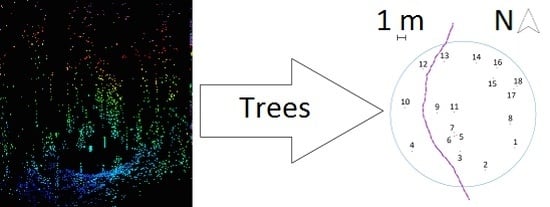Automatic Estimation of Tree Position and Stem Diameter Using a Moving Terrestrial Laser Scanner
Abstract
:1. Introduction
2. Instrumentation and Data Collection
2.1. Study Area and Field Reference Data Collection
2.2. ALS Data Acquisition
2.3. TLS Data Acquisition
3. Data Processing and Analysis
3.1. Processing Method
3.2. Point Group Classification
- Distance measurement increment threshold was set to 0.1 m;
- Maximum tree diameter was set to 0.5 m;
- Trees were assumed to be vertical.
3.3. Processing Method, Position, and Orientation Improvement
3.4. Processing Method, Height Adjustment
3.4.1. Height Adjustment Due to Poor 268 GNSS Conditions
3.4.2. Conversion into Height above Ground
3.4.3. Conversion of Estimated Tree Stem Diameters to Tree Stem Diameters at Breast Height
3.5. Clustering of Center Points
3.6. Evaluation
4. Results
5. Discussion
- Take actions to improve the GNSS accuracy, such as reduce the distance to the GNSS reference station;
- Use the ALS point cloud to extract the tree positions and perform matching per scan rotation to estimate a 2-dimensional translation and rotation for each scan rotation (c.f. Hauglin et al. [47]);
- Develop the proposed method into a three-dimensional SLAM system;
- The trees are assumed to grow vertically. In cases with low orientation accuracy, the trees can be used to estimate an average initial roll and pitch angle.
6. Conclusions
Author Contributions
Conflicts of Interest
References
- Vauhkonen, J.; Maltamo, M.; McRoberts, R.E.; Næsset, E. Introduction to forestry applications of airborne laser scanning. In Forestry Applications of Airborne Laser Scanning; Springer: Berlin/Heidelberg, Germany, 2014; pp. 1–16. [Google Scholar]
- Næsset, E. Predicting forest stand characteristics with airborne scanning laser using a practical two-stage procedure and field data. Remote Sens. Environ. 2002, 80, 88–99. [Google Scholar] [CrossRef]
- Liang, X.; Kankare, V.; Hyyppä, J.; Wang, Y.; Kukko, A.; Haggrén, H.; Yu, X.; Kaartinen, H.; Jaakkola, A.; Guan, F.; et al. Terrestrial laser scanning in forest inventories. ISPRS J. Photogramm. Remote Sens. 2016, 115, 63–77. [Google Scholar] [CrossRef]
- Bayer, D.; Seifert, S.; Pretzsch, H. Structural crown properties of Norway spruce (Picea abies [L.] Karst.) and European beech (Fagus sylvatica [L.]) in mixed versus pure stands revealed by terrestrial laser scanning. Trees 2013, 27, 1035–1047. [Google Scholar] [CrossRef]
- Côté, J.-F.; Fournier, R.A.; Egli, R. An architectural model of trees to estimate forest structural attributes using terrestrial LiDAR. Environ. Model. Softw. 2011, 26, 761–777. [Google Scholar] [CrossRef]
- Hauglin, M.; Astrup, R.; Gobakken, T.; Næsset, E. Estimating single-tree branch biomass of Norway spruce with terrestrial laser scanning using voxel-based and crown dimension features. Scand. J. For. Res. 2013, 28, 456–469. [Google Scholar] [CrossRef]
- Hosoi, F.; Nakai, Y.; Omasa, K. 3-D voxel-based solid modeling of a broad-leaved tree for accurate volume estimation using portable scanning lidar. ISPRS J. Photogramm. Remote Sens. 2013, 82, 41–48. [Google Scholar] [CrossRef]
- Kankare, V.; Holopainen, M.; Vastaranta, M.; Puttonen, E.; Yu, X.; Hyyppä, J.; Vaaja, M.; Hyyppä, H.; Alho, P. Individual tree biomass estimation using terrestrial laser scanning. ISPRS J. Photogramm. Remote Sens. 2013, 75, 64–75. [Google Scholar] [CrossRef]
- Yang, X.; Strahler, A.H.; Schaaf, C.B.; Jupp, D.L.B.; Yao, T.; Zhao, F.; Wang, Z.; Culvenor, D.S.; Newnham, G.J.; Lovell, J.L.; et al. Three-dimensional forest reconstruction and structural parameter retrievals using a terrestrial full-waveform lidar instrument (Echidna®). Remote Sens. Environ. 2013, 135, 36–51. [Google Scholar] [CrossRef]
- Bienert, A.; Scheller, S.; Keane, E.; Mohan, F.; Nugent, C. Tree Detection and Diameter Estimations by Analysis of Forest Terrestrial Laser Scanner Point Clouds. In Proceedings of the ISPRS Workshop on Laser Scanning 2007 and Silvilaser 2007, Espoo, Finland, 12–14 September 2007; pp. 50–55. [Google Scholar]
- Hopkinson, C.; Chasmer, L.; Young-Pow, C.; Treitz, P. Assessing forest metrics with a ground-based scanning lidar. Can. J. For. Res. 2004, 34, 573–583. [Google Scholar] [CrossRef]
- Lovell, J.L.; Jupp, D.L.B.; Newnham, G.J.; Culvenor, D.S. Measuring tree stem diameters using intensity profiles from ground-based scanning lidar from a fixed viewpoint. ISPRS J. Photogramm. Remote Sens. 2011, 66, 46–55. [Google Scholar] [CrossRef]
- Moskal, L.M.; Zheng, G. Retrieving Forest Inventory Variables with Terrestrial Laser Scanning (TLS) in Urban Heterogeneous Forest. Remote Sens. 2012, 4, 1–20. [Google Scholar] [CrossRef]
- Simonse, M.; Aschoff, T.; Spiecker, H.; Thies, M. Automatic Determination of Forest Inventory Parameters Using Terrestrial Laserscanning. In Proceedings of the ScandLaser Scientific Workshop on Airborne Laser Scanning of Forests, Umeå, Sweden, 3–4 September 2003. [Google Scholar]
- Yao, T.; Yang, X.; Zhao, F.; Wang, Z.; Zhang, Q.; Jupp, D.; Lovell, J.; Culvenor, D.; Newnham, G.; Ni-Meister, W.; et al. Measuring forest structure and biomass in New England forest stands using Echidna ground-based lidar. Remote Sens. Environ. 2011, 115, 2965–2974. [Google Scholar] [CrossRef]
- Gorte, B.; Pfeifer, N. Structuring laser-scanned trees using 3d mathematical morphology. Int. Arch. Photogramm. Remote Sens. 2004, 35, 929–933. [Google Scholar]
- Lefsky, M.; McHale, M.R. Volume estimates of trees with complex architecture from terrestrial laser scanning. J. Appl. Remote Sens. 2008, 2, 023521. [Google Scholar]
- Pfeifer, N.; Gorte, B.; Winterhalder, D. Automatic Reconstruction of Single Trees from Terrestrial Laser Scanner Data. ISPRS Int. Arch. Photogramm. Remote Sens. Spat. Inf. Sci. 2004, XXXV, 114–119. [Google Scholar]
- Raumonen, P.; Kaasalainen, M.; Åkerblom, M.; Kaasalainen, S.; Kaartinen, H.; Vastaranta, M.; Holopainen, M.; Disney, M.; Lewis, P. Fast Automatic Precision Tree Models from Terrestrial Laser Scanner Data. Remote Sens. 2013, 5, 491–520. [Google Scholar] [CrossRef]
- Yu, X.; Liang, X.; Hyyppa, J.; Kankare, V.; Vastaranta, M.; Holopainen, M. Stem biomass estimation based on stem reconstruction from terrestrial laser scanning point clouds. Remote Sens. Lett. 2013, 4, 344–353. [Google Scholar] [CrossRef]
- Vonderach, C.; Voegtle, T.; Adler, P.; Norra, S. Terrestrial laser scanning for estimating urban tree volume and carbon content. Int. J. Remote Sens. 2012, 33, 6652–6667. [Google Scholar] [CrossRef]
- Andersen, H.-E.; Clarkin, T.; Winterberger, K.; Strunk, J. An Accuracy Assessment of Positions Obtained Using Survey- and Recreational-Grade Global Positioning System Receivers across a Range of Forest Conditions within the Tanana Valley of Interior Alaska. West. J. Appl. For. 2009, 24, 128–136. [Google Scholar]
- Hauglin, M.; Lien, V.; Næsset, E.; Gobakken, T. Geo-referencing forest field plots by co-registration of terrestrial and airborne laser scanning data. Int. J. Remote Sens. 2014, 35, 3135–3149. [Google Scholar] [CrossRef]
- Bienert, A.; Scheller, S.; Keane, E.; Mullooly, G.; Mohan, F. Application of terrestrial laser scanners for the determination of forest inventory parameters. Int. Arch. Photogramm. Remote Sens. Spat. Inf. Sci. 2006, 36, 5. [Google Scholar]
- Brolly, G.; Király, G. Algorithms for stem mapping by means of terrestrial laser scanning. Acta Silv. Lignaria Hung. 2009, 5, 119–130. [Google Scholar]
- Liang, X.; Litkey, P.; Hyyppa, J.; Kaartinen, H.; Vastaranta, M.; Holopainen, M. Automatic Stem Mapping Using Single-Scan Terrestrial Laser Scanning. IEEE Trans. Geosci. Remote Sens. 2012, 50, 661–670. [Google Scholar] [CrossRef]
- Hopkinson, C.; Lovell, J.; Chasmer, L.; Jupp, D.; Kljun, N.; van Gorsel, E. Integrating terrestrial and airborne lidar to calibrate a 3D canopy model of effective leaf area index. Remote Sens. Environ. 2013, 136, 301–314. [Google Scholar] [CrossRef]
- Liang, X.; Litkey, P.; Hyyppä, J.; Kaartinen, H.; Kukko, A.; Holopainen, M. Automatic plot-wise tree location mapping using single-scan terrestrial laser scanning. Photogramm. J. Finl. 2011, 22, 38–48. [Google Scholar]
- Puttonen, E.; Lehtomäki, M.; Kaartinen, H.; Zhu, L.; Kukko, A.; Jaakkola, A. Improved Sampling for Terrestrial and Mobile Laser Scanner Point Cloud Data. Remote Sens. 2013, 5, 1754–1773. [Google Scholar] [CrossRef]
- Trochta, J.; Král, K.; Janík, D.; Adam, D. Arrangement of terrestrial laser scanner positions for area-wide stem mapping of natural forests. Can. J. For. Res. 2013, 43, 355–363. [Google Scholar] [CrossRef]
- Astrup, R.; Ducey, M.J.; Granhus, A.; Ritter, T.; von Lüpke, N. Approaches for estimating stand-level volume using terrestrial laser scanning in a single-scan mode. Can. J. For. Res. 2014, 44, 666–676. [Google Scholar] [CrossRef]
- Bauwens, S.; Bartholomeus, H.; Calders, K.; Lejeune, P. Forest Inventory with Terrestrial LiDAR: A Comparison of Static and Hand-Held Mobile Laser Scanning. Forests 2016, 7, 127. [Google Scholar] [CrossRef]
- Forsman, M.; Holmgren, J.; Olofsson, K. Tree Stem Diameter Estimation from Mobile Laser Scanning Using Line-Wise Intensity-Based Clustering. Forests 2016, 7, 206. [Google Scholar] [CrossRef]
- Ryding, J.; Williams, E.; Smith, M.; Eichhorn, M. Assessing Handheld Mobile Laser Scanners for Forest Surveys. Remote Sens. 2015, 7, 1095–1111. [Google Scholar] [CrossRef]
- Terrasolid. TerraScan User’s Guide; Terrasolid Ltd.: Helsinki, Finland, 2011. [Google Scholar]
- Kraus, K.; Pfeifer, N. Determination of terrain models in wooded areas with airborne laser scanner data. ISPRS J. Photogramm. Remote Sens. 1998, 53, 193–203. [Google Scholar] [CrossRef]
- Velodyne Lidar, PUCK, VLP16. Available online: http://velodynelidar.com/vlp-16.html (accessed on 8 January 2017).
- Direct Mapping Solutions for UAVs. Available online: http://www.applanix.com/products/dms-uavs.htm (accessed on 8 January 2017).
- Hutton, J.; Bourke, T.; Scherzinger, B.; Hill, R. New Developments of Inertial Navigation Systems at Applanix; Wichmann: Heidelberg, Germany, 2007; pp. 201–213. [Google Scholar]
- Danezis, C.; Gikas, V. An iterative LiDAR DEM-aided algorithm for GNSS positioning in obstructed/rapidly undulating environments. Adv. Space Res. 2013, 52, 865–878. [Google Scholar] [CrossRef]
- MathWorks. Matlab. 2017. Available online: https://se.mathworks.com/ (accessed on 7 February 2017).
- Riisgaard, S.; Blas, M.R. SLAM for Dummies. A Tutorial Approach to Simultaneous Localization and Mapping; BibSonomy: Würzburg, Germany, 2003; p. 126. [Google Scholar]
- Arras, K.O.; Mozos, O.M.; Burgard, W. Using boosted features for the detection of people in 2d range data. In Proceedings of the 2007 IEEE International Conference on Robotics and Automation, Roma, Italy, 10–14 April 2007. [Google Scholar]
- Bucher, I. Circle Fit. 2004. Available online: https://se.mathworks.com/matlabcentral/fileexchange/5557-circle-fit/content/circfit.m (accessed on 15 December 2016).
- Bergström, P.; Edlund, O. Robust registration of point sets using iteratively reweighted least squares. Comput. Optim. Appl. 2014, 58, 543–561. [Google Scholar] [CrossRef]
- Bergström, P. Iterative Closest Point Method. 2016. Available online: https://se.mathworks.com/matlabcentral/fileexchange/12627-iterative-closest-point-method (accessed on 11 March 2016).
- Hauglin, M.; Næsset, E.; Gobakken, T. Assessing the accuracy of co-registered terrestrial and airborne laser scanning data in forests. Proceeding of the ForestSat 2014, Garda, Italy, 4–7 November 2014. [Google Scholar]

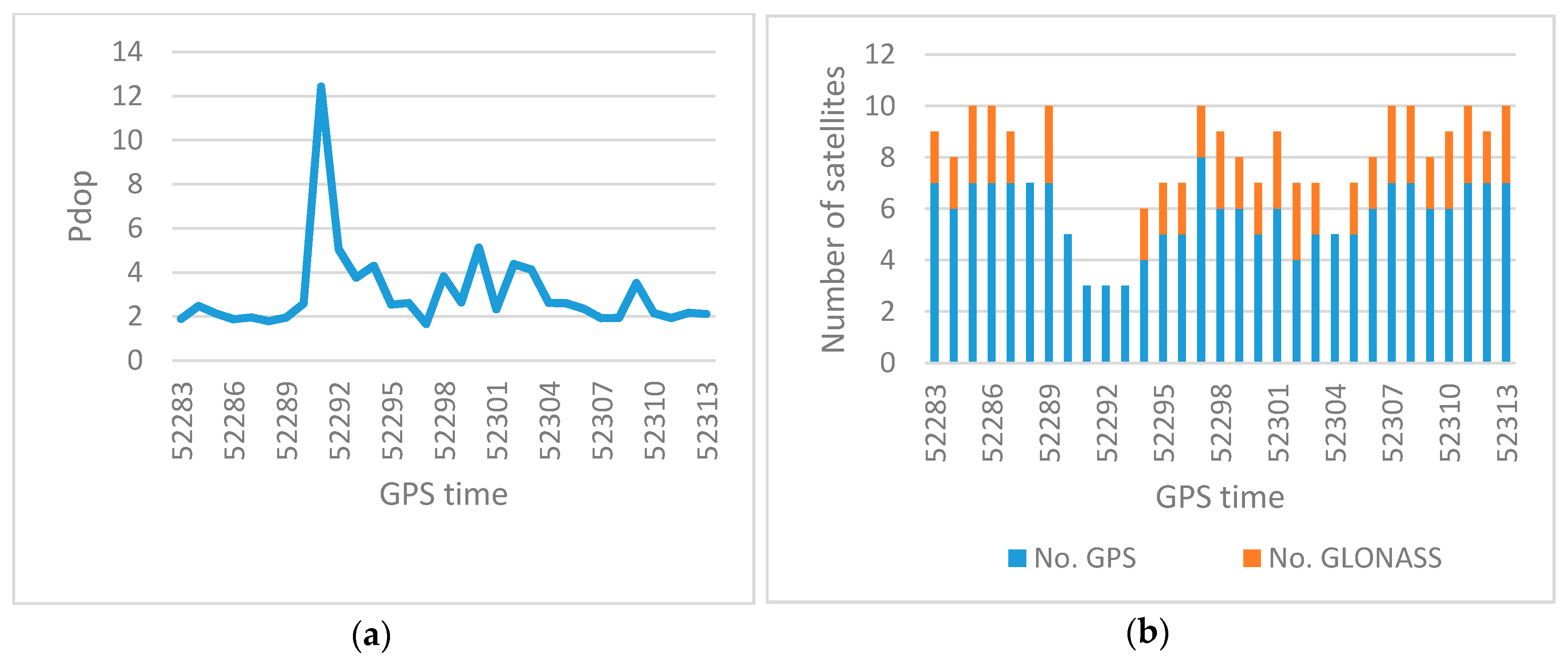
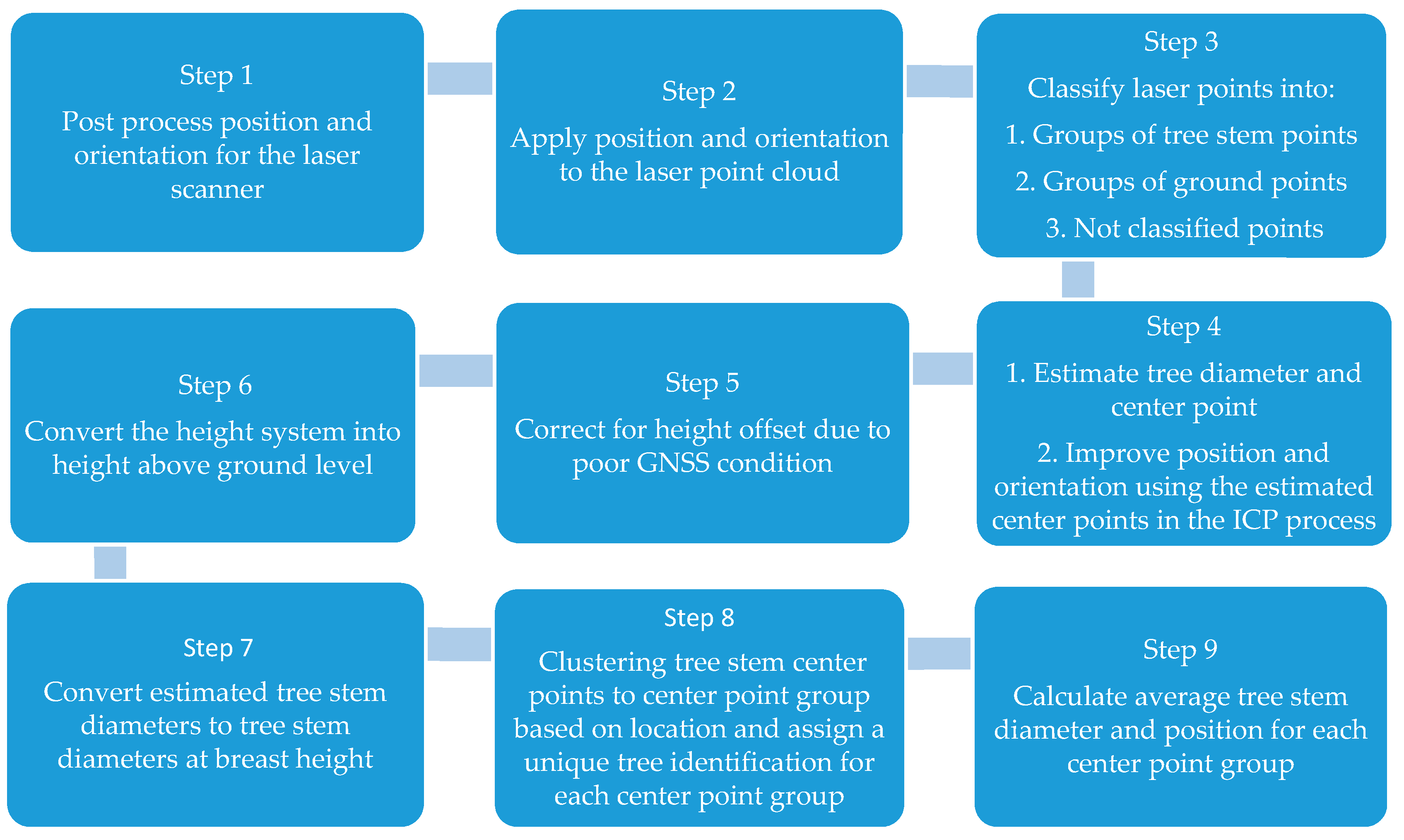
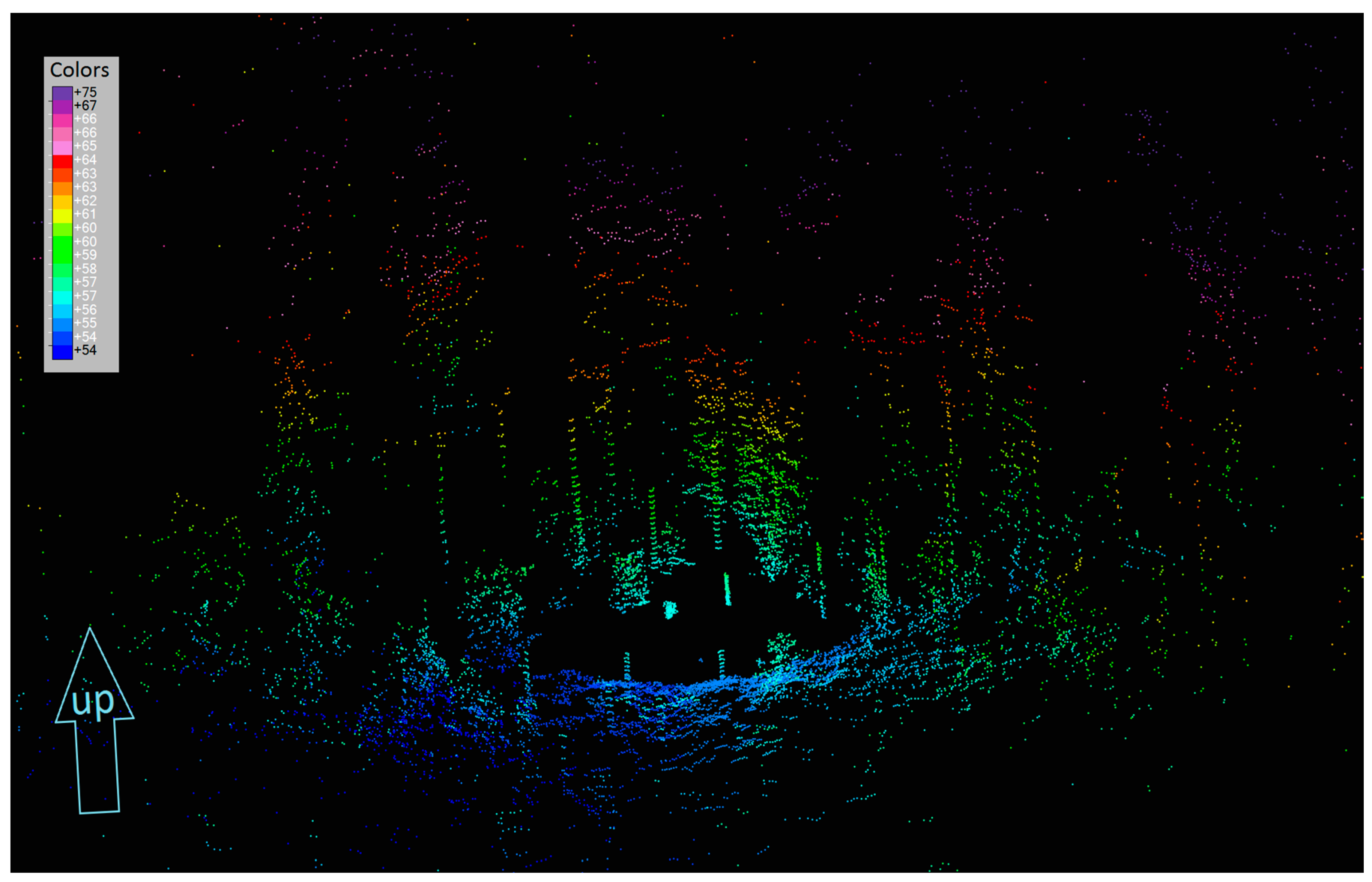
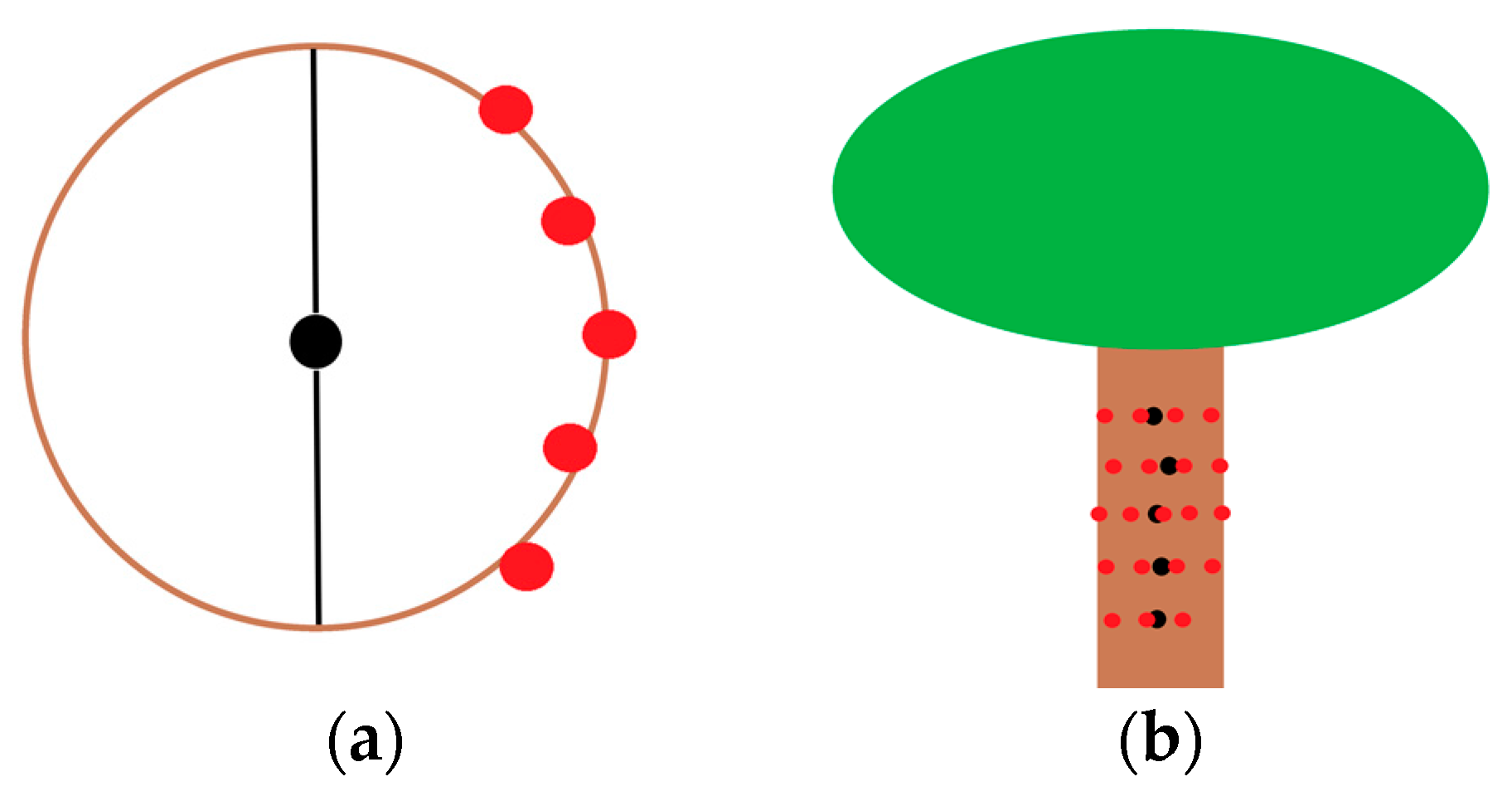
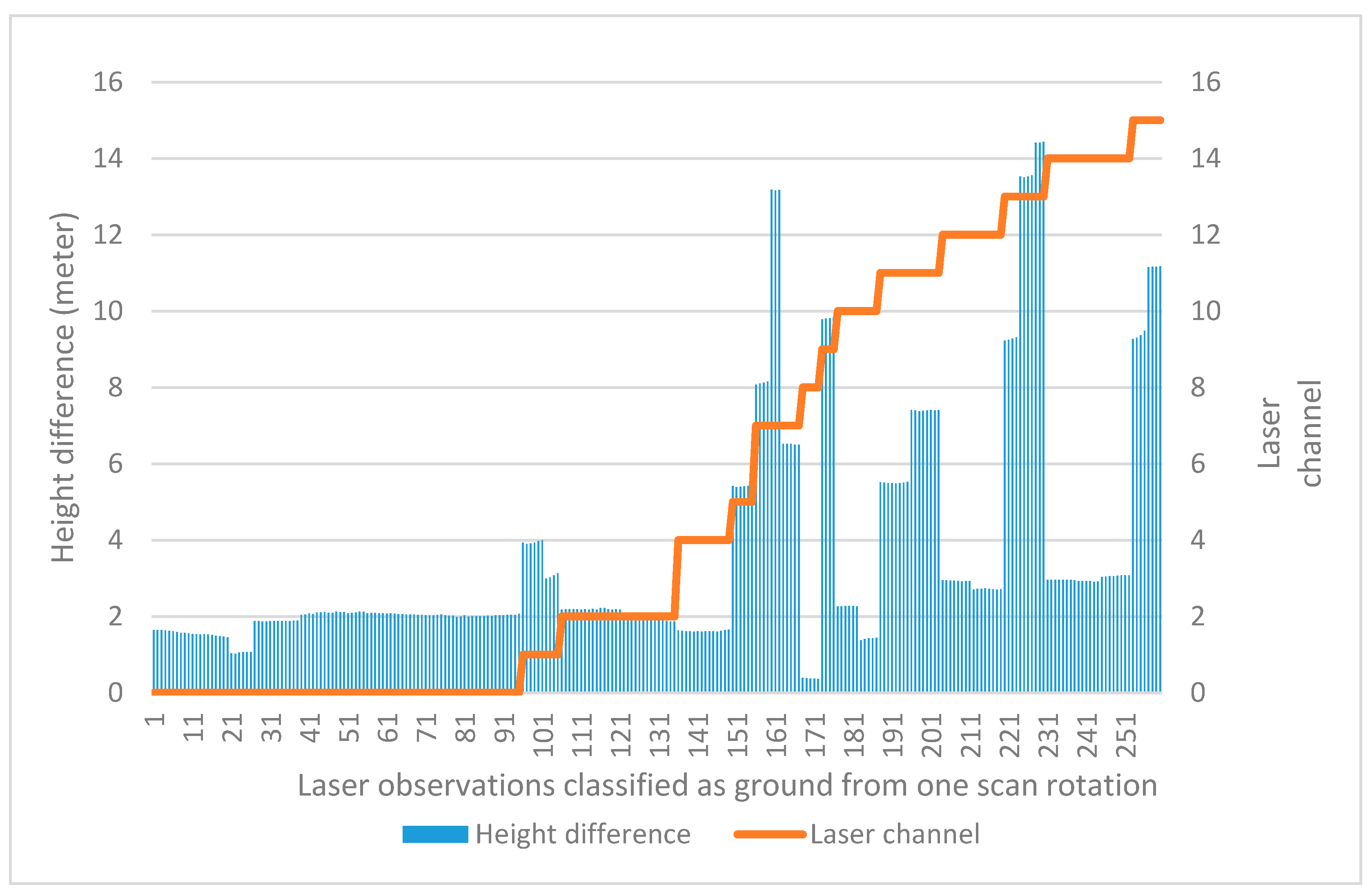
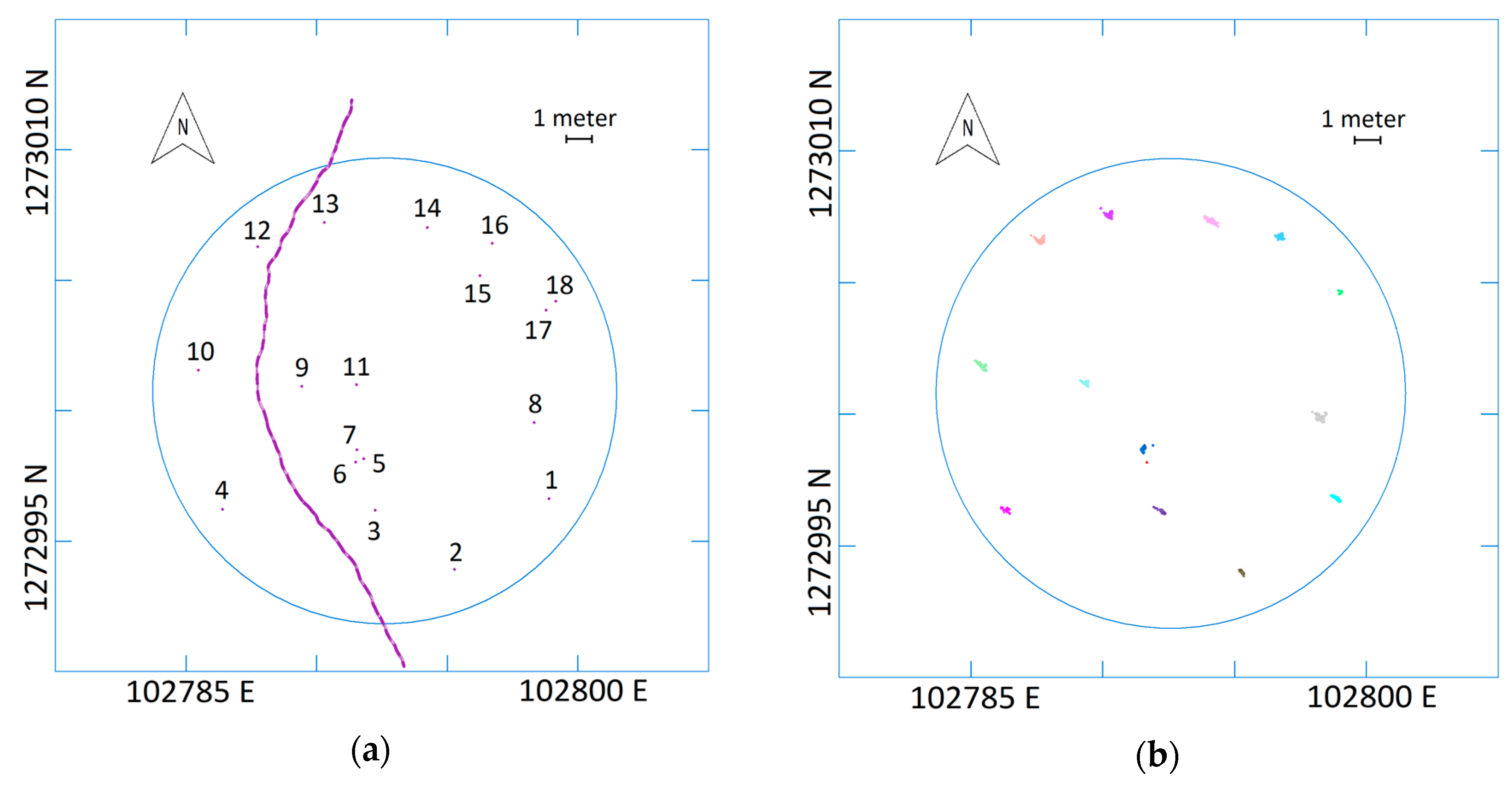
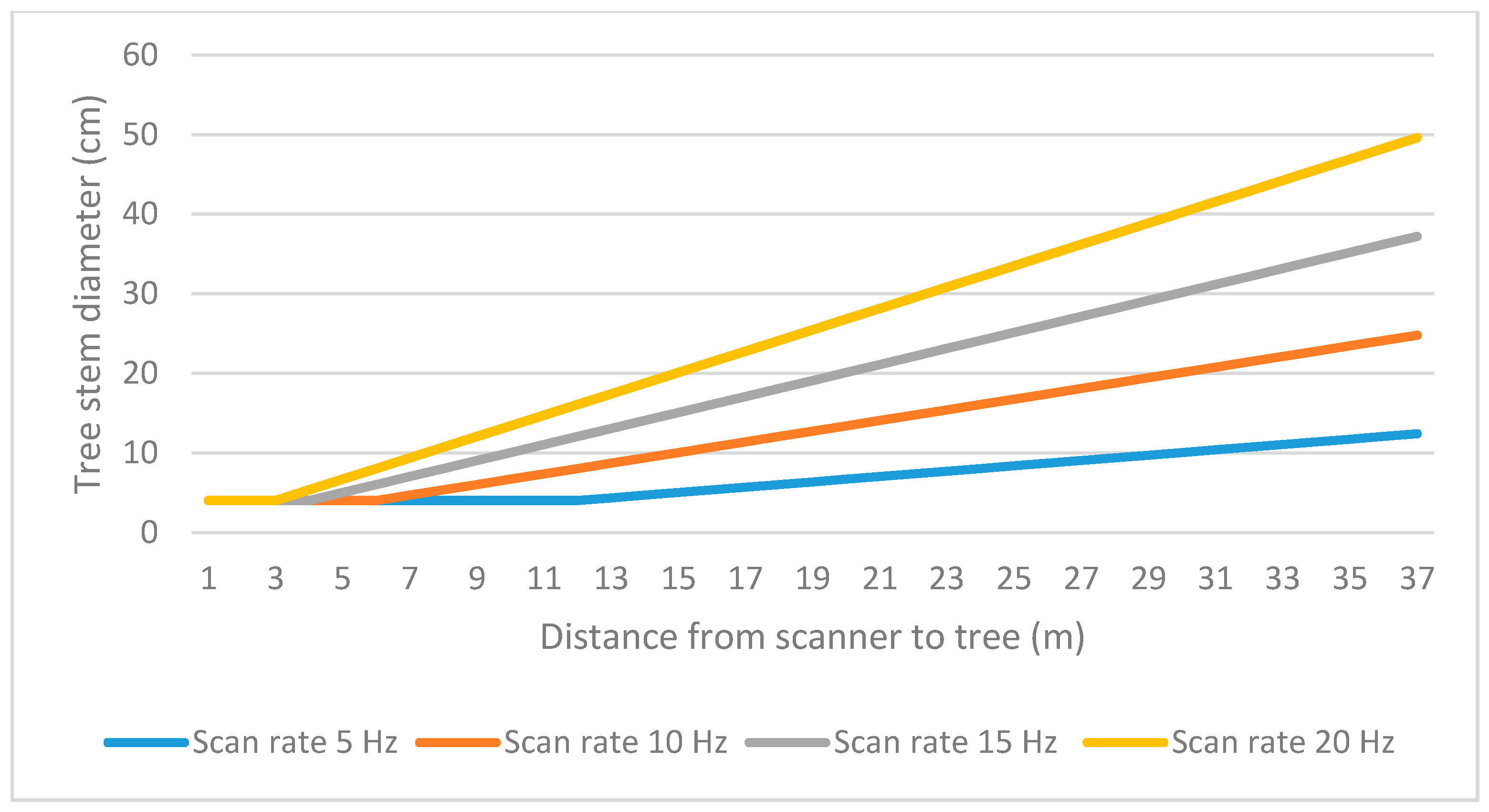
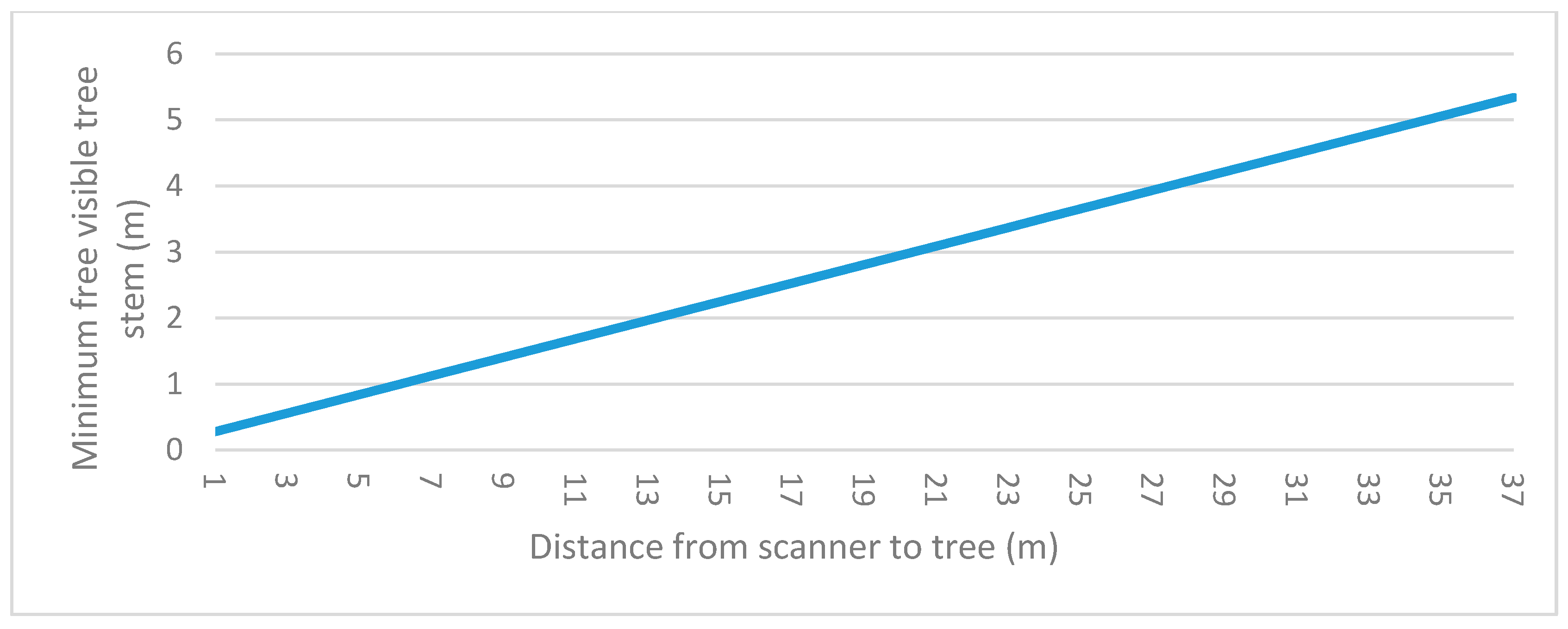
| Species | Number of Trees | DBH Min (cm) | DBH Max (cm) | DBH Mean (cm) |
|---|---|---|---|---|
| Pine | 12 | 19 | 39 | 25 |
| Spruce | 6 | 4 | 23 | 9 |
| All | 18 | 4 | 39 | 19 |
| Tree ID | Estimated DBH | No. of Laser Points | Min. Dist. | Max Dist. | Field Reference DBH | Difference between Field Reference and Estimated DBH | Detect-Able Tree Diameter a |
|---|---|---|---|---|---|---|---|
| 1 | 20.3 | 2800 | 728 | 820 | 20.4 | 0.1 | 10 |
| 2 | 25.3 | 18,628 | 385 | 1630 | 27.2 | 1.9 | 5 |
| 3 | 21.4 | 22,707 | 248 | 630 | 22.6 | 1.2 | 4 |
| 4 | 22.2 | 1850 | 699 | 1190 | 22.5 | 0.3 | 9 |
| 5 | 8.3 | 26 | 240 | 180 | 7.9 | −0.4 | 4 |
| 6 | NIL | 250 | 1140 | 5.6 | 4 | ||
| 7 | 26.0 | 7994 | 574 | 950 | 27.0 | 1.0 | 8 |
| 8 | 23.6 | 5689 | 944 | 1310 | 23.6 | 0.0 | 13 |
| 9 | 19.8 | 29,719 | 398 | 940 | 20.7 | 0.9 | 5 |
| 10 | 19.3 | 20,203 | 651 | 1210 | 21.4 | 2.1 | 9 |
| 11 | NIL | 370 | 9300 | 4.2 | 5 | ||
| 12 | 24.7 | 33,816 | 450 | 1310 | 27.3 | 2.6 | 6 |
| 13 | 17.9 | 33,122 | 364 | 1000 | 19.0 | 1.1 | 5 |
| 14 | 23.8 | 11,624 | 741 | 1050 | 23.5 | −0.3 | 10 |
| 15 | NIL | 720 | 1380 | 5.8 | 10 | ||
| 16 | 26.1 | 9496 | 826 | 1080 | 25.1 | −1.0 | 11 |
| 17 | NIL | 1010 | 1350 | 7.0 | 14 | ||
| 18 | 36.0 | 160 | 1050 | 1160 | 39.0 | 3.0 | 14 |
| Number of Trees | Mean Difference (cm) | RMSE (cm) | RMSE% |
|---|---|---|---|
| 14 of 18 | 0.9 | 1.5 | 7.5 |
| Number of Trees | Mean Difference (m) | RMSE (m) |
|---|---|---|
| 14 of 18 | 0.21 | 0.23 |
© 2017 by the authors. Licensee MDPI, Basel, Switzerland. This article is an open access article distributed under the terms and conditions of the Creative Commons Attribution (CC BY) license (http://creativecommons.org/licenses/by/4.0/).
Share and Cite
Oveland, I.; Hauglin, M.; Gobakken, T.; Næsset, E.; Maalen-Johansen, I. Automatic Estimation of Tree Position and Stem Diameter Using a Moving Terrestrial Laser Scanner. Remote Sens. 2017, 9, 350. https://doi.org/10.3390/rs9040350
Oveland I, Hauglin M, Gobakken T, Næsset E, Maalen-Johansen I. Automatic Estimation of Tree Position and Stem Diameter Using a Moving Terrestrial Laser Scanner. Remote Sensing. 2017; 9(4):350. https://doi.org/10.3390/rs9040350
Chicago/Turabian StyleOveland, Ivar, Marius Hauglin, Terje Gobakken, Erik Næsset, and Ivar Maalen-Johansen. 2017. "Automatic Estimation of Tree Position and Stem Diameter Using a Moving Terrestrial Laser Scanner" Remote Sensing 9, no. 4: 350. https://doi.org/10.3390/rs9040350





